Make-up artist Ana Takahashi discusses growing pains, being a nerd, and a return to the individual.
Photographs by Liv Liberg
Make-up by Ana Takahashi
Hair by Olivier Schawalder
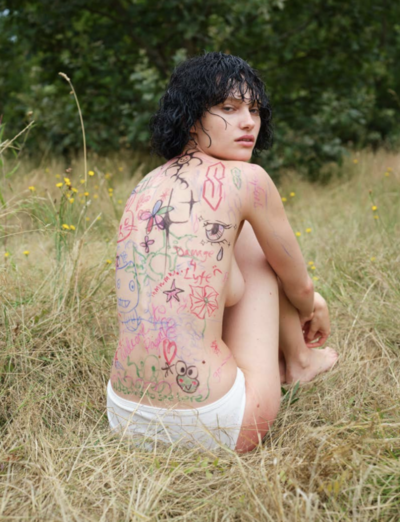
Make-up artist Ana Takahashi discusses growing pains, being a nerd, and a return to the individual.
In three short years, Ana Takahashi has gone from relative obscurity to industry-wide acclaim – an unusual trajectory for a young make-up artist. But Takahashi has never been one to play by the rules. ‘If someone tells me to do something, I just want to do it even less,’ she says. Growing up in South West London, she spent her formative years experimenting with make-up that her mother – a manager in the beauty department at Duty Free – would bring home from work. Renouncing conventional standards of beauty (and her mother’s unsolicited beauty advice) Takahashi’s approach to make-up was punk and instinctual. ‘I just wanted to look like a baddie,’ she muses.
After dropping out of beauty school in 2019 – she found the course too constraining – Takahashi was able to focus on her personal work, eventually catching the eye of photographers Nick Knight, with whom she worked on a conceptual visual album for Gareth Pugh’s Spring/Summer 2021 collection, and Harley Weir, who invited her to work on her seminal self-portrait series. Since then, Takahashi has keyed looks for brands such as Miu Miu, Marc Jacobs, Balenciaga and Blumarine, building up a reputation for her emotionally resonant images and layered character work. Here, she talks to System beauty about the transformative powers of make-up and the perils of being a perfectionist.
Tish Weinstock: Tell me about the inspiration behind your shoot for this issue.
Ana Takahashi: We’ve accidentally gone a bit autobiographical. Liv [Liberg] wanted to shoot a girl in a field – summer vibes, very pure and whimsical. But what I took from that was, ‘Let’s just make this a really angsty, bored girl who is at home all summer.’ Growing up, I would stay indoors all summer and ruin my mum’s make-up doing horrible looks on myself. I was also inspired by this Japanese artist called Aya Takano, who creates lanky female figures with red raw joints, which went with this idea of growing pains. In our story, it actually looks like sunburn, because we were shooting the girl outside. So you can interpret it in different ways. But I like the idea of this girl having growing pains and them manifesting in the red joints.
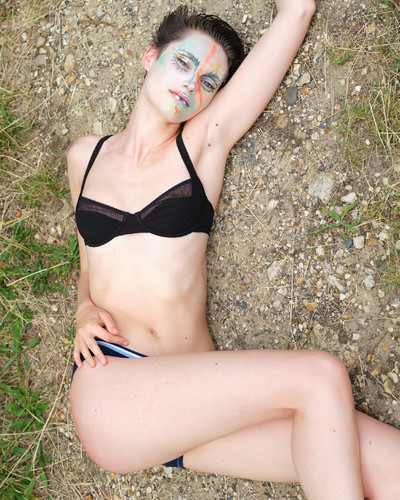
As teenagers, we often experiment with make-up as a way to deal with these growing pains, as we come to terms with our own image. Was that the case for you?
I was painfully insecure and it didn’t really help that I grew up in South West London at a catholic school where all the girls were white, blonde and had blue eyes. I was this half Asian, half Brazilian, weird looking person. I used to watch this woman called Michelle Phan on YouTube, who would transform herself into Angelina Jolie or Edward Scissorhands with make-up. She also used eye tape to make herself look more Western. I remember being quite fascinated by the transformative aspect of make-up, because I didn’t like my face. I learnt some really good skills along the way. So, my relationship with beauty was born out of insecurities, but then transformed into a love of playing with make-up.
What was the first product you played with?
A Lancôme mascara that my mum brought back from work. She was a manager in the beauty section of Duty Free so she would get loads of free make-up. Whenever I was experimenting with make-up, she would give pointers, which I hated because at that time your mum is the enemy. She wanted me to look classy and stunning and not like someone who has watched too many Lady Gaga videos.
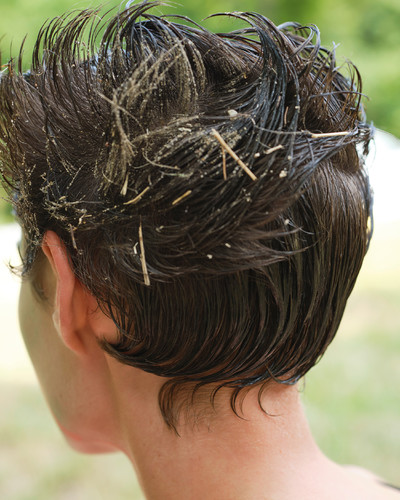
What was it about Gaga’s approach to make up that resonated with you?
She was such a big influence on me back in her heyday, when I was about 12. Val Garland did most of her make-up looks and she worked with Nick Knight on a lot of the imagery. I used to copy her really ornate double wing eyeliner looks and the duo chrome sparkling eyeshadow. Anything that was going to get me noticed. I’d spend hours on my make-up for parties. People would always comment on it when I arrived, and I loved that, it made me feel seen.
When did you start to think of make-up as a career?
I did a make-up course at London College of Fashion, but some of the techniques we learnt felt quite dated and I didn’t like how academic it was. I’d go home and look at techniques on YouTube, which I thought were better and easier. I started getting asked by friends, mainly fashion students, to do make-up for their projects which is how I got the best practice. I also started getting paid jobs, so I was working more outside of uni than I was going into uni so I just dropped out.
The first thing that probably put me on people’s radar was when I shot a film for Gareth Pugh with Nick Knight during the pandemic. Someone got Covid last minute and had to drop out. People must have seen that and thought, ‘OK, we can trust her.’ Then I started shooting with Harley Weir, who is obviously respected but also very young and fresh and has a very interesting view on beauty and shoots it in a very special way. I got so many requests after that.
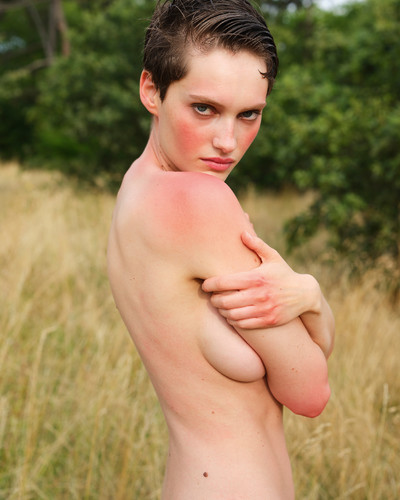
Tell me about your approach to beauty.
I’m quite a nerd when it comes to planning my looks. I think hard about what girl I’m going to use, how the make-up is going to sit on her face, what colours are going to look good on her, how the hair will inform the make-up. I always ask photographers before we shoot, ‘What’s the story here?’ Then I think about how the make-up can facilitate the greater narrative. I have a deep consideration for the composition of the make-up and that comes from studying the masters. Pat McGrath is an obvious inspiration. It’s very easy with make-up to take it too far so I have to police myself. I struggle to go with the flow, because I over plan and am quite OCD. With our shoot for this issue, I tried to be a bit more open and think less about what I’m doing.
Which is probably why it became autobiographical. The one time you relinquish control it speaks to a time when you used to mess around with make-up.
The shoot was based around naivety when approaching beauty, which is something I have lost now because it is my everyday life and I get paid to do this. The body painting was inspired by the kind of painting I used to do when I was 16, when I got my first watercolour Kryolan palette, I just changed the colours. It was an ode to that time when there was nothing polluting my brain.
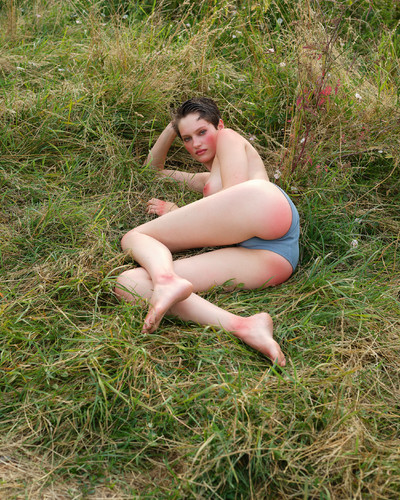
What are your biggest influences?
Travel. I went to Japan twice this year and that made a huge impression on me. There are things you can find abroad that you can never get here, like weird books and pieces of clothing. It’s like finding treasure, it’s really inspiring. Also my models inspire me. The vibe they bring informs the make-up.
How much does the notion of beauty play into your work?
I would be lying if I said I wasn’t trying to make things beautiful. Why bring more ugliness into the world? No thanks! But then who am I to say that’s what beauty is, because it would be just my preferences or taste.
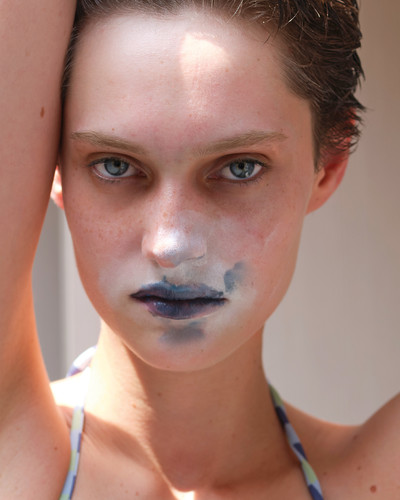
How do you see beauty evolving?
I just hope that individualism comes back. So many people pick their styles from a catalogue of archetypes. You can just go online and get any reference you like, so why bother coming up with something yourself? So I hope we go back to focusing on the individual and not try- ing to cater to whatever is popular at the time.